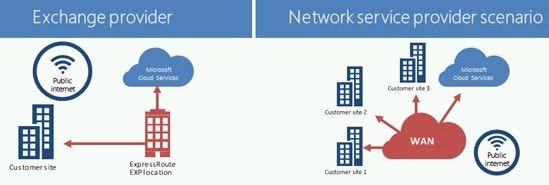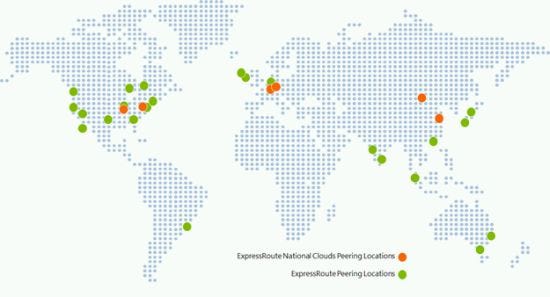The What, Where, Who, How — And Why of Azure ExpressRoute
Microsoft’s cloud is growing exponentially. Are you ready to jump on board?
May 19, 2016


 By Jo Peterson and Mike Goodenough
By Jo Peterson and Mike Goodenough
In a January blog, Microsoft’s Mike Neil stated that Azure is gaining nearly 100,000 new subscriptions per month. That’s about 3,300 per day. Yes, you read that correctly — per day. Neil is the executive who helped establish the Microsoft Hyper-V hypervisor and who is now general manager of Azure.
The first question that comes to mind for many of you is, “How are all those new subscribers connecting to the cloud?”
Previously, the answer likely was direct Internet access. This method wasn’t extremely secure, however, and there was associated latency. The Microsoft team responsible for Azure, which is typically consumed by midmarket to enterprise clients, listened to subscribers’ concerns about connectivity into the Azure cloud. They introduced ExpressRoute for Azure.
What Is ExpressRoute?
ExpressRoute is a private connection to the Microsoft Azure Cloud. It’s available by utilizing an ExpressRoute Provider colocation facility. Microsoft calls them Exchange Service Providers (EXPs) or Network Service Providers (NSPs).

ExpressRoute comes in three distinct flavors: point-to-point, MPLS or direct connect within a data center.
What Bandwidths Are Available?
Exchange Provider
Typical Connectivity Model | Connectivity at a Cloud Exchange | MPLS or point-to-point |
|---|---|---|
Supported Bandwidths | 200 Mbps, 500 Mbps, 1 Gbps, 10 Gbps | 10 Mbps, 50 Mbps, 100 Mbps, 500 Mbps, 1Gbps |
Routing | BGP sessions directly with customer edge routers | BGP sessions with carrier |
Where Can My Customers Connect?
There are approximately 10 domestic Azure cloud nodes, with two designated strictly for government cloud, and 12 international cloud nodes where clients can gain NSP (network service provider) connectivity.

The table below gives a map of the various Azure regions that are mapped to ExpressRoute locations.
Geopolitical Region | Azure Regions | ExpressRoute Locations |
|---|---|---|
U.S. | All U.S. | Atlanta, Chicago, Dallas, New York, Seattle, Silicon Valley |
U.S. Gov’t | Iowa, Virginia | Ashburn, Virginia; Chicago |
South America | Brazil South | Sao Paulo |
Europe | Northern & Western Europe | Amsterdam, London, Dublin |
Asia | East & Southeast Asia | Hong Kong, Singapore |
Japan | Western & Eastern Japan | Tokyo, Osaka |
Australia | Southeast & East Australia | Melbourne, Sydney |
India | Western, Central & Southern India | Chennai, Mumbai |
The Who: Which NSPs and EXPs Offer an ExpressRoute connection?
There are approximately 10 NSPs that offer ExpressRoute connections in the United States. Among them are AT&T (via NetBond), Aryaka, BT, CenturyLink, Comcast, Level 3, Orange, Tata, Verizon and Zayo. Note that these providers do not offer service into all ExpressRoute locations.
As you move into the rest of the world, the NSP provider landscape changes. Providers with regional footprints fold into the mix. Alternatively, there are a number of domestic colocation providers that have become exchange service providers (EXPs). These include but aren’t limited to Equinix, CoreSite and CyrusOne.
As an interesting side note, customers are actually re-architecting their topologies to gain proximity to the Azure Cloud for mission-critical applications such as Office365. We’re seeing clients stand up single racks, which are geographically dispersed, to create a redundant hybrid environment.
How Does It Work?
We’ve covered the “what” and “where.” Let’s look at the “how.” With ExpressRoute, the customer orders a dedicated circuit. With this circuit, they can establish a dedicated connection to the Microsoft Cloud. The diagram shows this type of setup:

The dedicated circuit has three distinct route paths. These are public, private and Microsoft. Microsoft ensures redundancy by configuring each circuit on a pair of active-active or load-balanced routers. Private peering into the Azure Cloud is established for compute. Public peering is used for storage, SQL databases and websites requiring a public IP. Customers can connect their extranets and all Azure services on their public IPs without the need to traverse the Internet.
What’s Next?
Connecting circuits to the Azure platform is just the start. We’re already starting to see the rollout of applications, such as Office 365, that can be securely connected to the Azure cloud.
We believe the next three years will be groundbreaking in terms of the next-generation products and capabilities Microsoft will roll out. There will be parallels made to the time when Windows 95, Windows 98 and NT 4.0 were released. Microsoft products will support development of a client’s own applications as well as the transformation of legacy applications and data-management tools. Most industries will need several years to catch up to the capabilities — which means now is the time for partners to get up to speed on how we can continue to be of value to our clients.
In our view, the simplicity of connecting to the Azure platform will enable clients to consume innovative tools and open new insights that will require updated policies and procedures for standard operations as well as new services. All of this needs to be handled with a strategic approach that includes quantifiable goals. Clients will be measuring and monitoring the consumption of these technologies. Becoming versed in the Microsoft cloud’s capabilities will help you have the conversations that are going to matter more and more to your clients.
How? The Azure platform will shift the conversation from fire drills and managing licenses. Instead, we’ll be working with clients to develop policies and procedures; work on recovery; implement and administer security; and manage voice, network and data with true authentication. From the SMB space to large enterprise, newfound capabilities will enable trusted advisers to shift their focus to areas that we literally have been dreaming of the past couple of years.
Leveraging a strategic approach, we’ll be able to provide metrics that can be reported. This capability can be tied to capacity planning, resulting in simplified workload management. Our work can result in a true road map — one that will help clients measure success around consumption and implementation of new technologies.
Your journey can start with a circuit. The next steps are up to you.
Read more about:
AgentsAbout the Author
You May Also Like


